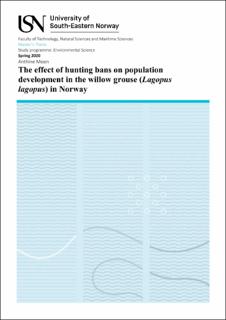The effect of hunting bans on population development in the willow grouse (Lagopus lagopus) in Norway
Master thesis
Published version
Permanent lenke
https://hdl.handle.net/11250/2721133Utgivelsesdato
2020Metadata
Vis full innførselSamlinger
Sammendrag
The willow grouse (Lagopus lagopus) is by far the most popular small game species in Norway, and it is hunted annually throughout the country. However, during the last 20 years it has experienced a continuous decline, and this has raised serious conservation concerns among wildlife managers. Several management actions have been implemented to mitigate this decline (e.g. geographical zoning, daily bag limits, reduced hunting periods), but more recently the use of complete hunting bans has been applied by a number of hunting districts. However, little is still known about the effects on population development of such bans. Here, I investigate the immediate (one year after the ban) and short-term (two years after the ban) density effects of hunting bans to see if such a management strategy would be effective in mitigating population declines. In calculating population development, I used two density measures: population growth rate (λ) and true density (i.e. a yearly change in the number of individuals), which were based on line-transect data from 96 hunting districts in Norway. I found an immediate positive effect on population development after a hunting ban, both when comparing the preceding five years and the last year before a ban to the first year after a ban. This effect was stronger for banned areas compared to both regulated and hunted areas. I also found a stronger positive effect for longer bans (1-year vs. 2-year), but this was only significant for measures of density. It is therefore to be concluded that future management should aim to prolong bans in areas when needed in order to see a true positive effect of hunting bans.
